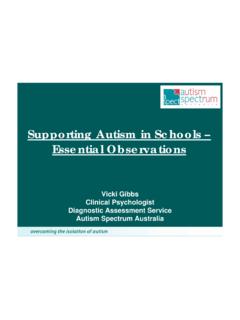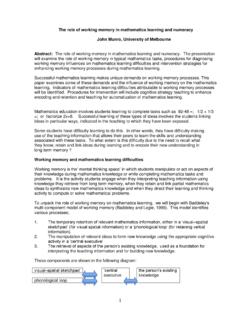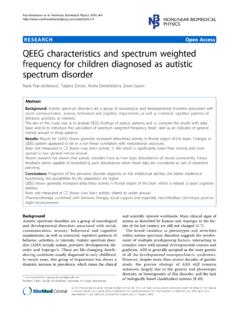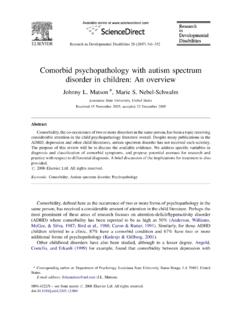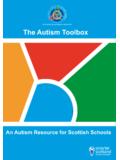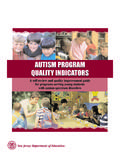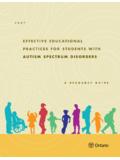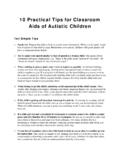Transcription of Supporting Autism in Schools – Essential Observations
1 Supporting Autism in Schools . Essential Observations Vicki Gibbs Clinical Psychologist Diagnostic Assessment Service Autism spectrum Australia Focus of Presentation - Core deficits versus associated features - Observable characteristics of ASD in mainstream Schools - Commonly used screening tools - Components of a comprehensive assessment process Core Deficits in ASD. 1. IMPAIRED COMMUNICATION. 2 3. IMPAIRED REPETITIVE BEHAVIOURS. SOCIAL RELATING & RESTRICTED INTERESTS. 1. Social Interaction Lack of socio-emotional reciprocity refers to social give and take, connectedness with other people.
2 Not smiling when smiled at, inappropriate social responding like laughing for no apparent reason, failing to offer comfort to others in distress Difficulty developing/sustaining peer relationships. Children with ASD may be uninterested in other children their age or may demonstrate very clumsy social interactions. wanting to go to John's house to use the play station rather than for the opportunity to play with John, may ignore approaches of other children Social Interaction (cont). Limited use and understanding of socio-emotional cues such as facial expression, vocal tone, body gestures, eye gaze poor eye contact when conversing, unusual voice quality, little use of communicative gesture Lack of shared enjoyment/interests not showing parent after making new train route, not offering to share things, not pointing out objects of interest 2.
3 Communication Delay in, or total lack of, spoken language (without compensation through alternative modes of communication, gesture). Difficulty initiating and sustaining reciprocal conversation no interest in social chat OR talking AT someone rather than conversing WITH someone Communication (cont). Idiosyncratic, stereotyped, repetitive use of language using the term rain doctor to refer to an umbrella, TV. talk . Impaired imaginative and imitative play appropriate to developmental level does not enjoy social games, little pretend play with dolls, teddies etc, does not play role play games with other children.
4 3. Restricted and repetitive interests and behaviours Attachments/interests that are unusual in their quality, intensity or focus knowing all the bus routes and bus registration numbers including how long ago you caught the bus, obsessed with certain topic for months or years Pokemon, Star Wars Inflexible adherence to non-specific routines and rituals refusing to get out of pyjamas until the sun rises, insisting on sitting on a particular chair and having food arranged a particular way when eating Restricted and repetitive interests and behaviours (cont).
5 Stereotyped motor mannerisms finger flicking, flapping, jumping up and down, spinning Interest in non-functional object parts flicking toy car doors/spinning wheels, staring at the ceiling fan, peering at a collection of toy street signs rather than playing with them The Autism spectrum Profound degree Mild degree of impairment of impairment Communication impairment Impaired social relating Repetitive behaviours and restricted interests Associated Features Sensory hyper- and hypo- sensitivities Motor clumsiness Self-injurious behaviours Epilepsy Allergies, vitamin deficiencies etc Information processing difficulties Intellectual impairment (except in Asperger's).
6 Learning disabilities Vulnerability to psychopathology, depression, anxiety (more common in High-Functioning Autism /. Asperger's Disorder). Associated characteristics of thinking and learning 1. Theory of Mind Baron-Cohen et al (1985). False belief test;. Sally-Anne test Perspective taking, ability to predict other's behaviour 2. Central Coherence attention to detail rather than looking at the big picture . Stephen Wiltshire : Royal Albert Hall, drawn aged 9. 3. Executive Functioning - inattentiveness - poor planning and problem-solving - inflexible thinking style - difficulties with emotion regulation - impulsivity 5.
7 Literal Thinking We'll go in a give me a minute hand . pull up your socks . 6. Visual Processing Style Difficulty shifting attention between auditory and visual information Better memory for non-verbal material Stronger skills in encoding visuo-spatial information compared with auditory information. Better at understanding and remembering information that remains stable and poorer at understanding transitory information such as speech. These visual strengths and auditory weaknesses have a significant impact on the ability to attend to, encode, understand and remember auditory information Quill, 1997.
8 Essential Observations What can you look for? Teachers and school staff are invaluable sources of information for paediatricians or psychologists who are assessing a child for possible ASD. As Autism is primarily a social impairment, Observations of a child's functioning in a social setting with same-aged peers can provide vital information. Eye contact does the child make direct eye contact with you when talking with you? Facial expression does the child exhibit a range of facial expressions, including subtle expressions, that are directed to you to communicate affect?
9 Are they appropriate to the situation/subject matter? Any inappropriate laughing/smiling? Use of gesture does the child use communicative gesture nodding and shaking his head, shrugging shoulders, descriptive gestures when speaking Does the child have age appropriate peer relationships? Are they mutual relationships with same age peers? Do they initiate contact with other children and respond appropriately when other children approach them? Are they able to engage in cooperative group play? Take turns? Understand rules? Do they share enjoyment and excitement with others?
10 Do they demonstrate empathy offering comfort to another child who is distressed? Conversational skills can the child converse about a range of everyday topics? When answering questions do they elaborate on their responses for your benefit? Do they respond to comments in a way that shows some interest in what you have just introduced? Do they understand humour? Any evidence of overly literal interpretation? Do they chat with their peers just to be friendly? Unusual speech/voice features does he/she speak with appropriate pitch, tone, inflection, rate?
